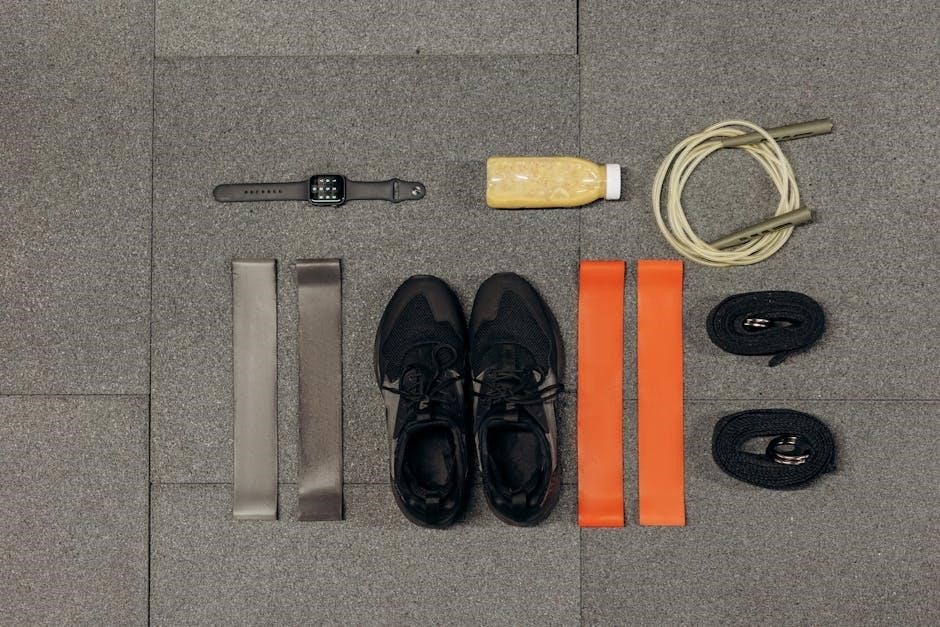The Bigger Faster Stronger (BFS) workout plan is a comprehensive‚ year-round program designed to enhance strength‚ speed‚ and muscle growth for athletes․ It emphasizes core lifts‚ structured set-rep progression‚ and continuous progress tracking‚ ensuring athletes consistently break personal records while focusing on overall athletic development․
1․1 Overview of the Bigger Faster Stronger Program
The Bigger Faster Stronger (BFS) program is a comprehensive training system designed to enhance strength‚ speed‚ and muscle mass․ It caters to athletes and individuals seeking a structured approach to fitness․ The program emphasizes a combination of strength training‚ conditioning‚ and flexibility‚ with a focus on progressive overload to achieve continuous improvement․ By integrating periodized workouts and a scientifically based set-rep system‚ BFS ensures balanced development and peak physical performance․ Its adaptability makes it suitable for various fitness levels‚ from beginners to advanced trainees․
1․2 History and Development of the BFS System
The Bigger Faster Stronger (BFS) system was developed in the 1970s by American coaches seeking to optimize athletic performance․ It originated as a structured‚ science-based program for high school and college athletes‚ focusing on strength‚ speed‚ and overall athleticism․ Over time‚ BFS evolved to incorporate modern training methods‚ emphasizing periodization and progressive overload․ Its adaptability and proven results have made it a popular choice for athletes across various sports and fitness levels․
1․3 Key Principles of the BFS Workout Plan
The BFS system is built on core principles that prioritize intensity‚ progression‚ and structure․ It emphasizes a focus on compound lifts‚ progressive overload‚ and periodization to ensure continuous improvement․ The program is designed to enhance strength‚ speed‚ and power while promoting muscular balance․ Athletes are encouraged to push their limits within a safe‚ guided framework‚ making it a results-driven approach for sports performance and overall fitness․

Structure of the Bigger Faster Stronger Workout
The BFS workout is organized around a 5-day split‚ focusing on strength‚ power‚ and hypertrophy․ It incorporates periodized training cycles to maximize progress and avoid plateaus․
2․1 The 5-Day Weekly Workout Split
The BFS program follows a structured 5-day workout split‚ balancing strength‚ power‚ and hypertrophy․ Each day focuses on specific muscle groups‚ ensuring optimal recovery․ Days are typically divided into: Squat/Power Clean day‚ Bench Press day‚ Auxiliary/Weak Point day‚ Deadlift day‚ and Speed/Agility day․ This split allows for targeted development while maintaining overall athleticism‚ ensuring athletes peak at the right time for competitions or seasonal goals․
2․2 Training Cycles and Periodization
The BFS program incorporates periodized training cycles to maximize progress and prevent overtraining․ It typically follows a macrocycle (annual plan)‚ broken into mesocycles (specific training phases) and microcycles (weekly plans)․ Each phase focuses on different goals‚ such as hypertrophy‚ strength‚ or power‚ ensuring athletes peak at the right time․ This structured approach optimizes performance and minimizes injury risk․
2․3 The Importance of Core Lifts
Core lifts‚ such as squats‚ deadlifts‚ and bench presses‚ are foundational to the BFS program․ They target major muscle groups‚ building overall strength and muscle mass․ These exercises improve athleticism‚ enhance joint stability‚ and promote balanced development․ By mastering core lifts‚ athletes establish a strong base‚ enabling better performance in sports and reducing injury risk․ They are the backbone of the BFS system‚ driving progressive overload and long-term success․

The BFS Set-Rep System
The BFS Set-Rep System is designed for progressive overload‚ ensuring continuous strength gains․ Athletes perform 3-5 sets of 3-8 reps for core lifts‚ optimizing muscle growth and power development effectively․
3․1 Understanding the Set-Rep Progression
The BFS Set-Rep System emphasizes progressive overload through structured set and rep schemes․ Athletes begin with higher reps (e․g․‚ 6-8) and lower weights to build muscle endurance‚ then gradually decrease reps (3-5) while increasing weight to focus on strength and power․ This progression ensures continuous improvement‚ prevents plateaus‚ and optimizes muscle growth․ The system is designed to adapt to individual fitness levels‚ ensuring safe and effective progression over time for all athletes․
3․2 How to Avoid Plateaus with BFS
To prevent plateaus‚ the BFS system incorporates progressive overload‚ exercise variation‚ and periodization․ Athletes are encouraged to increase weight‚ reduce rest time‚ or modify rep schemes regularly․ Additionally‚ focusing on proper form‚ recovery‚ and nutrition ensures continuous progress․ By consistently challenging the body and avoiding complacency‚ trainees can break through plateaus and maintain steady improvement in strength and performance over time with the BFS approach․
3․3 Practical Examples of Set-Rep Schemes
The BFS system offers clear set-rep schemes for different goals․ For strength‚ athletes might use 5 sets of 5 reps with increasing weights․ For hypertrophy‚ 4 sets of 8-12 reps are common․ Examples include squats (5×5) and bench press (4×8-10)․ Auxiliary exercises often use higher reps‚ like 3×12-15 for muscle balance․ Periodization ensures variation‚ such as shifting to 4×6-8 reps in later cycles to avoid stagnation and promote progressive overload․ These schemes are tailored to individual goals and experience levels‚ ensuring continuous progress and adaptation․

Key Exercises in the Bigger Faster Stronger Program
The BFS program emphasizes core lifts like squats‚ bench press‚ deadlifts‚ and power cleans to build strength‚ power‚ and muscle․ These exercises target major muscle groups and improve overall athleticism‚ forming the foundation of the workout plan․
4․1 Squats for Strength and Power
Squats are a cornerstone of the BFS program‚ targeting the quadriceps‚ hamstrings‚ glutes‚ and core․ They build functional strength‚ improve power‚ and enhance athleticism․ Proper form is emphasized to maximize results while minimizing injury risk․ Squats are performed with a full range of motion‚ engaging multiple muscle groups simultaneously․ This exercise is essential for developing lower body strength and explosive power‚ making it a priority in the BFS workout plan․
- Targets major muscle groups for overall lower body development․
- Improves functional strength and athletic performance․
- Emphasizes proper form to prevent injuries and optimize results․
4․2 Bench Press for Upper Body Development
The bench press is a foundational exercise in the BFS program‚ focusing on building chest‚ shoulder‚ and tricep strength․ It is performed with a barbell or dumbbells‚ emphasizing proper form to prevent injury․ The bench press improves upper body power and muscle mass‚ making it essential for athletes seeking enhanced performance․ Variations like incline and decline presses target different muscle fibers‚ ensuring comprehensive development․
- Targets chest‚ shoulders‚ and triceps for balanced upper body growth․
- Enhances strength and power for improved athletic performance․
- Varied grips and angles optimize muscle engagement․
4․3 Deadlifts for Overall Muscle Growth
Deadlifts are a cornerstone of the BFS program‚ engaging multiple muscle groups for total body development․ They target the back‚ legs‚ and core‚ building strength and muscle mass efficiently․ Proper form is crucial to avoid injury and maximize results․ Deadlifts improve posture‚ functional strength‚ and overall athletic performance‚ making them indispensable for any serious training regimen․
- Works multiple muscle groups simultaneously for efficient growth․
- Builds functional strength and improves posture․
- Essential for overall muscle development and athletic performance․
4․4 Power Cleans for Explosive Strength
Power cleans are a dynamic exercise in the BFS program‚ designed to enhance explosive strength and power․ This Olympic lift involves rapidly lifting a barbell from the floor to shoulder height‚ engaging the legs‚ hips‚ and core․ It improves acceleration‚ speed‚ and overall athleticism‚ making it a key component for athletes seeking to boost performance and build functional strength․
- Enhances explosive power and speed․
- Engages multiple muscle groups for functional strength․
- Crucial for improving athletic performance and acceleration․

Auxiliary Exercises and Their Role
Auxiliary exercises supplement core lifts‚ targeting smaller muscle groups to enhance overall development and prevent imbalances․ They improve joint stability‚ flexibility‚ and support long-term injury prevention‚ ensuring well-rounded athleticism․
- Target smaller muscle groups for balanced growth․
- Enhance joint stability and overall performance․
- Support injury prevention and recovery․
5․1 Auxiliary Exercises for Muscle Balance
Auxiliary exercises in the BFS program target smaller muscle groups to ensure balanced development․ They address muscle imbalances‚ improve joint stability‚ and enhance overall athleticism․ By strengthening secondary muscles‚ these exercises prevent injuries and optimize performance․ Proper muscle balance also promotes better movement mechanics‚ allowing athletes to perform core lifts more effectively․ Auxiliary work complements the main lifts‚ ensuring comprehensive strength and durability․
5․2 The Importance of Auxiliary Work
Auxiliary exercises are vital for enhancing strength‚ preventing injuries‚ and improving overall performance․ They target specific muscle groups‚ ensuring balanced development and addressing weaknesses․ By incorporating auxiliary work‚ athletes can improve joint stability‚ increase flexibility‚ and enhance muscle endurance․ This complementary training supports the core lifts‚ allowing for better overall progress and long-term success in the BFS program․ Auxiliary work is essential for achieving well-rounded athleticism․
5․3 Examples of Auxiliary Exercises
Auxiliary exercises include pull-ups‚ dumbbell presses‚ incline bench presses‚ and lunges․ These movements target specific muscle groups‚ enhancing overall strength and muscle balance․ Pull-ups improve lat development‚ while dumbbell work increases shoulder stability․ Lunges address leg imbalances and boost athleticism․ These exercises complement core lifts‚ ensuring comprehensive development and preventing injuries․ They are tailored to individual needs‚ making them essential for a well-rounded BFS training program․

Flexibility and Mobility in BFS
Flexibility and mobility are crucial for injury prevention‚ muscle recovery‚ and optimal performance in the BFS system‚ enhancing overall athleticism and training efficiency․
6․1 The BFS Flexibility Program
The BFS Flexibility Program emphasizes dynamic and static stretching to improve range of motion‚ reduce muscle tightness‚ and prevent injuries․ It incorporates pre- and post-workout routines‚ focusing on major muscle groups like hamstrings‚ quads‚ and shoulders․ The program also includes mobility drills to enhance joint flexibility and movement efficiency‚ ensuring athletes maintain optimal physical condition for peak performance․ Consistency is key to achieving long-term flexibility gains․
6․2 Dynamic Stretching for Athletes
Dynamic stretching is a cornerstone of the BFS program‚ designed to prepare athletes for intense workouts․ It involves active movements like leg swings‚ arm circles‚ and high knees to increase blood flow and flexibility․ Unlike static stretching‚ dynamic movements mimic athletic actions‚ improving range of motion and reducing injury risk․ BFS recommends performing these stretches before workouts to enhance performance and ensure muscles are ready for peak output․
6․3 Static Stretching and Its Benefits
Static stretching‚ held for 20-30 seconds‚ targets specific muscle groups to improve flexibility and range of motion․ Unlike dynamic stretching‚ it focuses on passive movements‚ ideal for post-workout recovery․ BFS incorporates static stretches to reduce muscle soreness and enhance relaxation․ Regular practice promotes long-term flexibility‚ complementing the program’s strength and power goals‚ ensuring athletes maintain optimal muscle balance and mobility․

Nutrition and Recovery in the BFS System
Nutrition and recovery are vital in the BFS system‚ ensuring athletes fuel their bodies for optimal performance and muscle growth․ A balanced diet combined with effective recovery techniques supports overall success․
7․1 The Role of Nutrition in Muscle Growth
Nutrition plays a critical role in muscle growth by providing essential nutrients for recovery and development․ Adequate protein intake is vital for muscle repair‚ while carbohydrates and fats supply energy․ Proper hydration and timing of meals further enhance growth‚ supporting the body’s ability to recover and adapt to the demands of the BFS program․ A well-planned diet ensures athletes can train intensely and achieve their goals effectively․
7․2 Caloric Intake and Macronutrient Balance
Caloric intake and macronutrient balance are essential for muscle growth and performance․ Athletes following the BFS plan need to consume enough calories to support energy needs and recovery․ A balanced diet typically includes 40% carbohydrates‚ 40% protein‚ and 20% fats․ This ratio ensures adequate fuel for workouts‚ muscle repair‚ and overall health․ Proper macronutrient distribution helps athletes maintain strength‚ endurance‚ and muscle mass throughout the program․
7․3 Recovery Techniques for Optimal Progress
Recovery is critical for muscle repair and growth in the BFS system․ Techniques include foam rolling‚ dynamic stretching‚ and cold therapy to reduce muscle soreness․ Adequate sleep‚ proper nutrition‚ and hydration are also emphasized․ Active recovery‚ such as light cardio‚ promotes blood flow without overtaxing muscles; These strategies ensure athletes can train consistently‚ avoid injuries‚ and achieve optimal progress in strength and performance․

Tracking Progress and Setting Goals
Track progress through workout logs‚ strength gains‚ and physique changes․ Set specific‚ achievable goals aligned with your training cycle․ Regular assessments ensure accountability and motivate consistent effort․
8․1 How to Track Workout Progress
Track workout progress by logging exercises‚ weights‚ and repetitions․ Use a training journal to monitor strength gains and consistency․ Take progress photos and body measurements weekly or bi-weekly․ Adjust training plans based on observed improvements․ Celebrate small victories to stay motivated and ensure long-term adherence to the BFS program․
8․2 Setting Realistic Goals for Strength and Size
Set specific‚ measurable‚ and achievable goals aligned with your fitness level․ Break larger objectives into smaller‚ manageable milestones․ Aim for incremental strength gains‚ such as a 5% increase in lift weights monthly․ For size‚ focus on gradual muscle growth of 0․5-1% body weight monthly․ Ensure goals are time-bound and relevant to your training phase․ Adjust targets periodically to reflect progress and maintain motivation․
8․3 The Importance of Consistency
Consistency is the cornerstone of the Bigger Faster Stronger program․ Regular training and proper recovery ensure progressive overload‚ essential for muscle growth and strength gains․ Sticking to the workout schedule and nutrition plan fosters long-term commitment․ Avoid sporadic efforts‚ as steady progress is key․ Consistency reinforces discipline and builds habits‚ driving sustained results and helping athletes achieve their full potential in strength and size․

Benefits of the Bigger Faster Stronger Program
The Bigger Faster Stronger program enhances overall physical performance‚ boosting strength‚ speed‚ and endurance․ It improves coordination and mental toughness‚ preparing athletes for peak performance in sports․
9․1 Increased Strength and Muscle Mass
The Bigger Faster Stronger program is renowned for its ability to significantly increase strength and muscle mass․ By focusing on core lifts like squats‚ bench presses‚ and deadlifts‚ athletes build foundational power․ The set-rep system ensures progressive overload‚ stimulating muscle growth․ Proper nutrition and recovery further enhance hypertrophy‚ leading to noticeable gains in size and strength over time․
9․2 Improved Speed and Agility
The Bigger Faster Stronger program enhances speed and agility through targeted exercises and drills․ Plyometrics‚ sprinting‚ and agility ladder drills improve explosiveness and quickness․ Dynamic stretching and flexibility work also contribute to better movement efficiency․ These components are tailored to help athletes excel in their sports‚ translating to faster reactions and sharper cuts on the field‚ making BFS a comprehensive system for athletic development․
9․3 Enhanced Athletic Performance
The Bigger Faster Stronger program is designed to elevate overall athletic performance by combining strength‚ speed‚ and agility training․ Athletes experience improved power output‚ enabling them to jump higher‚ run faster‚ and change direction more quickly․ The program’s focus on functional movements and sport-specific drills ensures that gains translate directly to the field‚ court‚ or track‚ making BFS a powerful tool for achieving peak performance in any sport․

Success Stories and Testimonials
Athletes and coaches worldwide praise the BFS program‚ sharing remarkable gains in strength‚ speed‚ and overall performance‚ solidifying its reputation as a transformative training system․
10․1 Athlete Testimonials and Results
Athletes across various sports praise the BFS program for delivering exceptional results․ Many report significant strength gains‚ improved speed‚ and enhanced overall performance․ For instance‚ high school football players have added 50+ pounds to their bench press‚ while track athletes achieved personal bests in sprint times․ The program’s focus on core lifts and progressive overload has helped athletes break through plateaus and achieve new levels of athleticism‚ making it a trusted choice for competitive success․
10․2 Coaches’ Feedback on the BFS Program
Coaches widely endorse the BFS program for its structured approach and measurable results․ Many highlight its effectiveness in improving both strength and speed‚ with teams reporting enhanced overall performance․ The focus on core lifts and progressive overload is particularly praised for building well-rounded athletes․ Coaches also appreciate the program’s adaptability to different sports and skill levels‚ making it a versatile tool for achieving team and individual success consistently․
10․3 Scientific Validation of the BFS System
The BFS system is supported by scientific research‚ particularly in the areas of periodization and progressive overload․ Studies have shown that the program’s focus on core lifts and structured set-rep schemes enhances strength‚ power‚ and muscle growth․ The emphasis on proper form and injury prevention aligns with biomechanical principles‚ ensuring safe and effective training․ This evidence-based approach has made BFS a trusted method among athletes and coaches for achieving measurable results․
The Bigger Faster Stronger system is a comprehensive‚ proven method for enhancing strength‚ speed‚ and muscle․ Follow the plan consistently to achieve transformative results․
11․1 Final Thoughts on the Bigger Faster Stronger Program
The Bigger Faster Stronger program is a scientifically backed‚ results-driven system․ Its structured approach ensures progressive overload‚ promoting strength‚ speed‚ and muscle growth․ By adhering to the set-rep schemes and training cycles‚ athletes can achieve exceptional gains․ The program’s emphasis on core lifts‚ auxiliary exercises‚ and recovery fosters well-rounded development․ Consistency is key to unlocking its full potential and transforming performance․
11․2 Encouragement to Start the BFS Journey
Embarking on the Bigger Faster Stronger journey is a transformative step toward unlocking your full athletic potential․ With its proven system‚ you’ll gain strength‚ speed‚ and confidence․ Stay committed‚ and celebrate small victories along the way․ Embrace the discipline‚ and watch your hard work yield remarkable results․ Take the first step today and unleash your inner athlete—your journey to greatness starts now․